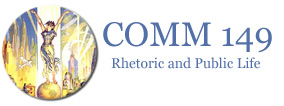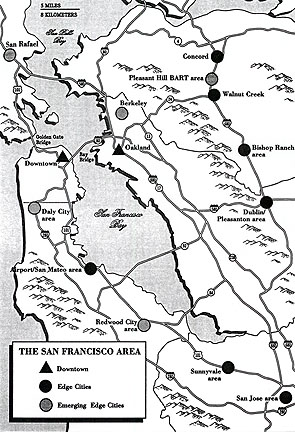
Office: HGH 210; phone: (408) 924-5378
Email: wooda@email.sjsu.edu
Web: http://www.sjsu.edu/faculty/wooda

|
Dr. Andrew Wood Office: HGH 210; phone: (408) 924-5378 Email: wooda@email.sjsu.edu Web: http://www.sjsu.edu/faculty/wooda |
 Silicon Valley is a perfect topic for
this class because it is a wholly rhetorical creation. This map, borrowed Joel
Garreau's (1991) Edge City provides one potential view of Silicon Valley.
But, like all maps, this image tells more about the mapmaker than the territory.
After all, there is no political boundary called "Silicon Valley." Since the term
entered the public lexicon in the 1970s, various groups have struggled to "fix"
the borders to this unique manifestation of public life. Yet, the boundaries keep
changing!
Silicon Valley is a perfect topic for
this class because it is a wholly rhetorical creation. This map, borrowed Joel
Garreau's (1991) Edge City provides one potential view of Silicon Valley.
But, like all maps, this image tells more about the mapmaker than the territory.
After all, there is no political boundary called "Silicon Valley." Since the term
entered the public lexicon in the 1970s, various groups have struggled to "fix"
the borders to this unique manifestation of public life. Yet, the boundaries keep
changing!
Is Silicon Valley more like Hollywood than a "traditional" city? Langdon Winner suggests that it is, noting that the "valley" is more a state of mind than a reality. In her essay, Jan English-Lueck describes the results of hundreds of interviews - and her search for metaphors and themes that emerge as people and groups try to articulate their understanding of this locale. When studying rhetoric and public life, we are confronted with the challenge of selecting artifacts that denote a strictly discursive image. We seek pictures, texts, speeches, and other components to form a narrative of "Silicon Valley" that is internally coherent and externally valid.
Activity
In small groups, you will employ one perspective to construct a narrative of Silicon Valley - as if you were explaining it to a visitor. The theme of this assignment is to describe how public life is shaped in this rhetorical environment. Our goal is to discover that different rhetorical standpoints of the "valley" reveal different visions of public life. Here is a list of the standpoints to be discussed: